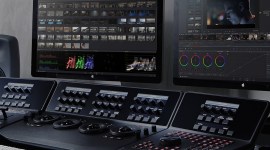
DaVinci Resolve Tips: Pull Better Keys
The experienced colorist is able to pull fast keys to ensure the session progresses at a quick pace. Here are a couple of actionable DaVinci Resolve tips to make sure your keys are effective.
Digital colorists pull keys on any and every object in the frame throughout their careers. Clients always ask to tweak skin tones, but elements such as clothing, hair, teeth, lips, scenery, product packaging, or practical lights are all fair game.
Here’s the first image we’ll be working with. We should be able to get a nice clean key of the girl’s skin as it is naturally separated from the background.

Hue Width, Saturation Low and Luminance Low
Create an initial qualification by selecting the eyedropper tool and clicking and dragging across the part of the image you want. You’ll often find that your initial selection won’t include all the values you want, and choosing the Add Color Range tool can be slower than knowing what to adjust next.
Using the eyedropper tool, this is our initial key. Not bad, but we can do better. Read on…

Activate the highlight mode and increase the Hue Width. This will fatten out the qualification, often to include the tones you need. I don’t find myself adjusting Hue Center, Soft or Symmetry as often as Hue Width. If you’ve performed a good initial selection with the eyedropper, you’ve already got a good center hue, and you’ll be wanting to select an area that is defined enough to process, so it won’t be too softened out. Symmetry adjusts the highs and lows of the hue qualification, something I haven’t found crucial for most keys.
Adjusting the Hue Width may be all you need to move on. If not, try adjusting both Saturation Low and Luminance Low to include or exclude as needed. Many times I won’t need to touch the Highs of both controls.
Increasing the Hue Width gets us a key that includes more of what we want.

When you’ve pulled a good key, don’t forget to blur it by increasing your Blur Radius, an important step for executing seamless corrections.
I adjusted both the Luminance Low and Saturation Low to get a bit more of her hair. There’s a tradeoff because I’m also now getting some values in her jacket that are the same tone as her hair and skin. It’s up to you to determine whether you’re okay with affecting this part of the image in service of improving the hair. You can also choose to exclude the jacket using power windows. If so, read on. Don’t forget to blur your key.

The qualification tab has many parameters for precisely dialing in the part of the image you want to key. Knowing how all of these affect keys is essential, but several have more of an immediate impact that you’ll find yourself adjusting more than the others. Identifying and understanding which qualifier parameters get you better keys will keep you from guessing what to change and will save time in session.
Use Power Windows to Choke Keys
Sometimes, the subject’s skin will have the same red-yellow values as something else in the frame. You’ll have to decide if your skin correction is worth affecting this other element in the interest of making the talent look their best.
This is a harder image to work with since the model’s skin is a similar tone to the background, but we’re up for the challenge.

Sure enough, when we pull our key we’re getting the background, as expected.

You may opt to create power windows to restrict the limits of your key, especially if your correction is a large move.
Here’s our skin tone correction. I thought she was a bit too saturated and yellow.

The added benefit to using power windows is that you can create an Outside Node to affect what’s outside your correction.
Add Outside Node lets us process everything that’s not in the skin tone key we pulled earlier, allowing us other creative possibilities.

Our resulting grade. I cooled it off quite a bit for a look favoring a bit more color contrast.

Don’t Go Nuts on Exposure. Use Power Windows Instead
When performing the correction on the keyed image, you can make large moves on the color information, adjusting saturation, hue, and tint in substantial degrees. This isn’t the case for luminance values. Large exposure adjustments will cause your footage to break down fairly quickly, depending on which camera you’re shooting with. Artifacts are the last thing you want on a shot with tons of nodes.
The experienced colorist uses discretion with keys, and knows when not to use one. When lightening or darkening in large amounts, it’s better to use a power window without a qualification.
Track When Necessary
If you’re improving skin tones on a relatively stationary subject, it may not be necessary to track. Many times the qualification will suffice. Resolve’s tracker, while fast, is not always perfect, and in a high-speed client session you want to execute fast changes in the allotted time, and the tracker may actually slow you down.
Brush Up on Keying
Creating clean keys is one of the most important skills to possess for the colorist executing professional work. Understanding the qualification tools, as well as knowing when to not use them, are just as important.
Check out some of our other color grading articles below.
- Color Grading: Bleach Bypass Looks in DaVinci Resolve
- The Isolated Color Look in DaVinci Resolve
- Popular Fashion Looks in Resolve
Were these DaVinci Resolve tips helpful? Got any secrets to pulling better keys? Share the goods in the comments below!





